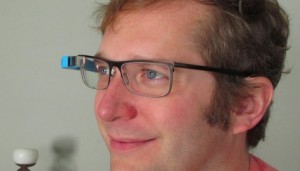Google Glass: Inspired by Terminator
-
-
slice.mit.edu
Filed Under
Recommended

As a student at MIT, Thad Starner '91, SM '95, PhD '99 longed for cyborg eyes like the Terminator had—but only to make studying easier. Now, Starner is the technical lead and manager on Google’s Project Glass, and he has been using a wearable computer in his everyday life for 20 years. In a half-hour talk before a screening of Terminator 2 at the Coolidge Corner Theatre, Starner cited his experience seeing the film as an MIT sophomore as a partial inspiration for his future work.
“For me, note-taking was the number one reason of having a wearable computer and having this head-up display,” Starner explained to the packed house at the Coolidge on May 20, 2013. “Not very sexy, is it?”
Starner found it difficult to remember his professors' lectures, but he also found his own handwriting impossible to read. “Believe it or not, back then, MIT professors often would not allow notebooks in class because the typing was too distracting,” Starner explained.
So, Starner began to use an early wearable computer, supplemented by a Twiddler, a small keyboard designed for one-handed use.
A handful of Starner's fellow MIT friends caught on to wearable computing as well, but not just in class. Some used their headsets to communicate during hacks.
“One of the guys was hacking around on the Great Dome one night, and some campus policeman came by and scared away his spotter. He couldn’t call the elevator. So, he’s on top of the Great Dome—this is 1996—and he’s sending messages out saying, ‘Help, somebody send up an elevator, I’m stuck on the Great Dome.’ The people on the Athena terminals—remember, there were no mobile phones, no mobile smartphones, laptops barely existed—people on the Athena terminals said, ‘Ha, ha—if you’re on the Great Dome, how can you be typing this?’
 This scene from Terminator 2
This scene from Terminator 2
“He spent the next half hour convincing the people on Athena that, yes … he was one of those guys you see wandering around with a display on.”
What can wearable computing do that can't be done with current mobile devices?
“This is what Larry Page said to me very early on with Project Glass,” Starner said. “[We’re] reducing the time between intention and action. I found a lot of studies that showed access time to your smartphone was really the barrier to use.”
Starner explains, by example, that people who still use wristwatches “have relegated time to their wrist.” So, Starner’s hope for Project Glass is that everyday tasks – “like, say, checking the weather, or seeing an SMS, or email” will become as accessible and easy as looking at a wristwatch.
Google's first trial round of 2,000 Glass users recently picked up their new tech, and the 8,000 winners of Google's recent “How I'd Use Glass” contest have earned the chance to participate in the Glass Explorer program. Keep your eyes peeled for nascent cyborgs in the wild.







